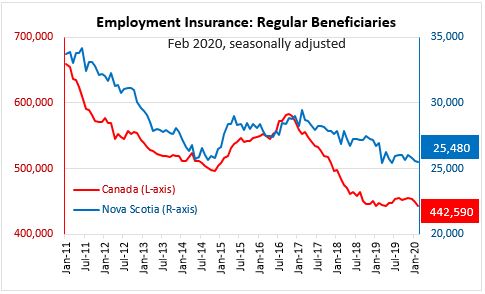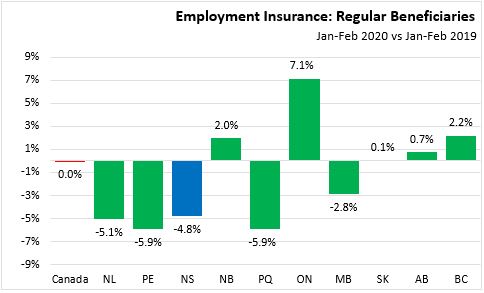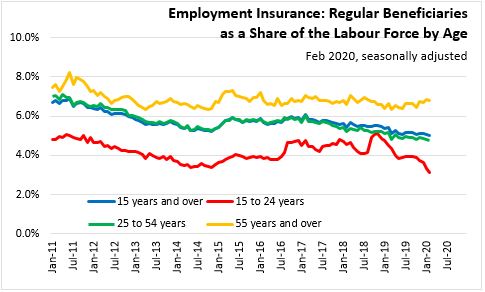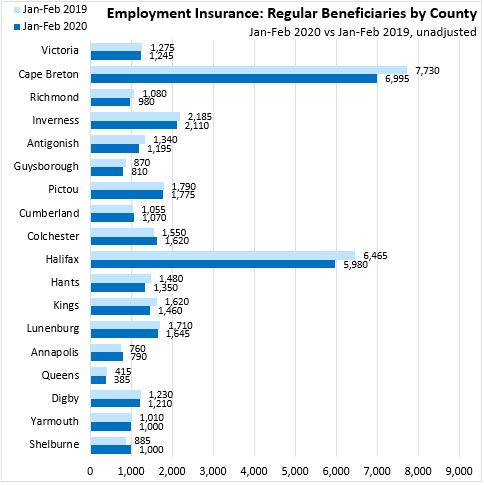The Economics and Statistics Division maintains archives of previous publications for accountability purposes, but makes no updates to keep these documents current with the latest data revisions from Statistics Canada. As a result, information in older documents may not be accurate. Please exercise caution when referring to older documents. For the latest information and historical data, please contact the individual listed to the right.
<--- Return to Archive
For additional information relating to this article, please contact:
April 16, 2020EMPLOYMENT INSURANCE, JANUARY AND FEBRUARY 2020 
Statistics Canada has released new information on employment insurance (EI) usage, covering January and February 2020. In January, Nova Scotia's seasonally adjusted EI usage declined by 250 (-1.0 per cent). In February, Nova Scotia's EI usage fell again by 60 (-0.2 per cent) to 25,480.
Nova Scotia's EI usage has been on a downward trend since 2017. February 2020 is only the third month (along with Mar-19 and Jun-19) since the start of the seasonally adjusted data series in 1997 when Nova Scotia's EI usage was below 25,500. The impacts of COVID-19 are expected to significantly increase EI usage in the coming months.
Year-over-year, Nova Scotia's EI usage was down 4.3 per cent from Jan-19 to Jan-20 and down 5.3 per cent from Feb-19 to Feb-20. Comparing average of the first two months of 2020 with the same months of 2019, Nova Scotia's EI usage was down 4.8 per cent. National EI usage was little changed as EI usage increased in Ontario, British Columbia, New Brunswick, Alberta and Saskatchewan. EI usage was down in Quebec, Prince Edward Island, Newfoundland and Labrador, Nova Scotia and Manitoba.

AGE
The bulk of EI beneficiaries in Nova Scotia are aged 25 to 54, who also account for the largest share of the labour force. In February, the number of beneficiaries aged 25-54 was unchanged compared to Jan-19 at 15,080. The number of beneficiaries aged 55 and older was also unchanged at 7,910 while the number of beneficiaries aged 15-24 decreased by 70 persons (-2.7 per cent) to 2,490.

EI BENEFICIARIES AS A SHARE OF THE UNEMPLOYED BY PROVINCE
The number (seasonally adjusted) of Nova Scotians receiving regular EI benefits in February 2020 accounted for 5.0 per cent of the total labour force. In Canada, the number of EI beneficiaries accounted for 2.2 per cent of the total labour force.
In Nova Scotia, EI beneficiaries accounted for 64.0 per cent of unemployed persons in February, compared to a Canadian rate of 39.0 per cent. Across the country, EI beneficiaries accounted for the highest share of the unemployed in the Atlantic provinces, led by New Brunswick and Prince Edward Island. EI beneficiaries accounted for the lowest share of the unemployed in Ontario, Alberta, and British Columbia.
Note that due to differences in estimation methodology, it is possible for the reported number of EI beneficiaries to exceed the reported number of unemployed in a given jurisdiction.

COUNTIES
Through February, EI usage (regular beneficiaries, unadjusted) was up in Cumberland, Colchester, Annapolis and Shelburne counties. Decreases in EI usage were reported in all other counties, with the largest decline in percentage terms in Antigonish (-10.8 per cent).

Note: Statistics Canada has not updated EI usage by occupation.
Source: Statistics Canada. Table 14-10-0011-01 Employment insurance beneficiaries (regular benefits) by province and territory, monthly, seasonally adjusted; Table 14-10-0287-01 Labour force characteristics, monthly, seasonally adjusted and trend-cycle, last 5 months; Table 14-10-0323-01 Employment insurance beneficiaries by census division, monthly, unadjusted for seasonality; Table 14-10-0337-01 Employment insurance beneficiaries (regular benefits) by province, territory and occupation, monthly, seasonally adjusted
<--- Return to Archive